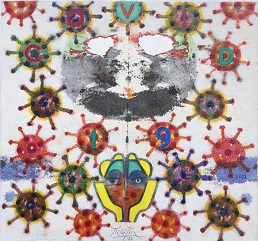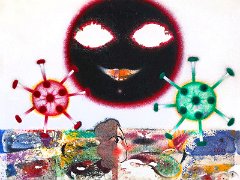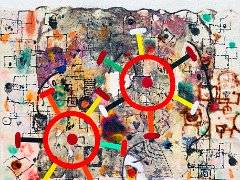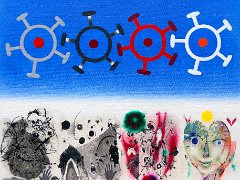
Anton Cetín
“What was really important for me was to leave the stamp of the time in which I lived,“ Anton Cetín saidin a conversation we had on the occasion of his recently completed series Covid-19.
When Mr. Anton Cetín sent me the image of the first painting from his Covid-19 series on May 14. I did not expect that I would have the privilege of following the creation of the whole series of 19 paintings, which I was finally able to view at the beginning of September. These paintings with Eve as a witness of the time, reflected a unpredictability of the coronavirus, just as scientific studies have revealed. After receiving the first nine paintings, my response to Mr. Anton Cetín was: “Something completely new!” So I was delighted when Mr. Anton Cetín agreed to an interview about his latest painting series.
Jasna Lovrincevic: “Your latest series Covid-19 is a rare artist’s response to this frightening pandemic disease. Through history, artists have thematized past infections much more, especially the emergence of the plague. The war, which is also disturbing and drastically life-threatening, has been a regular theme in almost all of the arts. However, artists remain mostly silent about the present-day coronavirus which has forced mankind, as scientifically and technologically advanced as we are, to resort to medieval methods of protection. Why have you decided to break the silence in this series?“
Anton Cetín: “From the very beginning the appearance of Covid-19, which is completely and irreversibly changing our previous reality into a completely new unimagined, unpredictably dramatic, frightening, perilous and worrying one, aroused in me the need to do something to react in my own, pictorial way – on canvas. The idea itself was not enough – it was necessary to think of what to paint and which elements would have to take precedence and which would be the best, the most picturesque to realize and show in such a complex and demanding task. And it wasn‘t simple and easy. And then how, by what technique or by what techniques to achieve all that. It was immediately clear to me that one painting would not be enough, that more of them would need to be painted – one larger series of paintings, the number of which was not really in sight at the time.
What was really important to me was to realize the idea in terms of leaving the stamp of the time in which I lived, the way I saw it, understood it, experienced it for the whole time I was painting it. That’s why I reacted in my own way, and I wasn’t silent. And that’s why I decided on this series.“
Jasna Lovrincevic: “Just before your departure for Paris, in 1965, your series of drawings of the Ominous Birds was created in Zagreb as a reflection of, as you said in one of our previous conversations in 2016, the ominous threat of apocalyptic proportions of the A bomb. The drawings, which you sent me, also strongly alluded to scenes from the Apocalypse: the devastated Earth, the smoke, hunger and exhaustion of the rare survivors, the self-destruction of man by his own technology, as well as the influence of cosmic forces. Has this, extremely imaginative series through the richness of drawings and especially shaded large dark as well as white surfaces, been an inspiration for your Covid-19 series?“
Anton Cetín: “It is true that in Zagreb in 1965, my series of drawings of the Ominous Birds was created as a reflection on ominous threats of apocalyptic proportions of the A bomb. All the rest of what you have stated in this question is also true. And, to be able to find an answer to this question in terms of the inspiration of the Ominous Birds series for the Covid-19 series, we must first go back to 1965, which means only 55 years back, so, in the year in which the scenes you mentioned in this question first appeared in my work. Some of these scenes from the Ominous Birds series became in fact a link to those in the Phantom series, created in Paris in 1967; and those from the Phantom series appear again in the Universe Desturbed series, created in Toronto, 2001; and now these scenes and symbols find their way to this new Covid-19 series.“
Jasna Lovrincevic: “In the first painting of Covid-19 series, which you showed me at the beginning of May 2020, one could notice the enigmatic number 2001, as I characterized it in my response after receiving that painting. The author Branka Hlevnjak in her text entitled New Series of Paintings by Anton Cetín Covid-19, published on the Epoha Portal in July 2020, stated that for this new series of paintings you have used forgotten, unpublished works from your series Universe Disturbed, created in 2001. This is a very interesting fact in addition to the fact that there were nineteen of those works.
That incredible coincidence with the number 19 that this horrible virus of unexplained origin contains in its name, as well as the connection with the Universe Disturbed series is strange. Did it come as a surprise to you? Did you perhaps accept this coincidence as synchronicity or as something connecting and anticipatory?“
Anton Cetín: “At the beginning of the spring of 2001, I started working on a series of paintings that did not have a title at that time. Early in the morning on 9/11, the day of the demolition of the World Trade Center in New York, I went to the city to do some work. As I was passing through the underground part of the buildings in one place I noticed a completely mute – silent and motionless bunch of people looking at something on the screen. It stirred my curiosity so I joined them and also saw the whole demolition. Those images impressed me terribly. I went back to the studio with the idea of recording it, but under the weight of everything I saw, I just wasn’t able to do anything. And when I looked around at the paintings I had been working on until then, the name Universe Disturbed emerged for them – at that moment I wasn’t even aware from where. One portion of the works on paper in the acrylic technique in preparation remained unused, so I stored it in a box and put it aside, completely forgetting about it.
Thinking about how I would start working on the Covid-19 series, I remembered the box. I opened the box and started counting, and to my great surprise there were exactly 19 of these unused works, which I simply – without any thought have decided to use. And so I decided on a series of 19 paintings. I accepted it as synchronicity because everything coincided in time, connecting because it was thematically related to previous events, and also as anticipatory because in my painting I sensed the arrival of something new – a new beginning.“
Jasna Lovrincevic: “Could you clarify if these works were unfinished and now in some way are completed, or have you painted over those paintings, leaving number 2001 visible?“
Anton Cetín: “These works were not previously completed, they waited while I worked on the Universe Disturbed series. I have transferred each of them to the canvas with a specific technique and I have painted new symbols over them related to this series – Covid 19. And since these unfinished works were created in 2001, I left the numbers visible for documentation. For example, in the upper part of the first painting of this series, one can see a character also painted in 2001 and now transferred to this series, a demon character in the role of generator of enormous energy of evil behind the viruses that dominate the entire image space accomplishing their task. From their empty dead whiteness, the white eyes of this character sow death. An evil satanic smile is a reaction to the doom that has befallen us and in which we are only helpless observers and victims.“

Anton Cetín – Covid-19, the First Painting
Jasna Lovrincevic: “In the first painting of this series, regardless of the frightening symbols, its symmetry and colours, lightness and brightness create a feeling of harmony and tranquility, as I wrote in reply after receiving the first picture. The following paintings reflect the horror and dramatic events that this virus has created in the world, showing its unpredictability. But, on the last image Eve appears smiling, symbolically representing the winner. In this sense, the whole series creates an optimistic impression. Has optimism guided you through the creation of this series?“
Anton Cetín: “Regardless of everything shown in the paintings, from the first to the last, optimism has carried me the whole time I worked on this series and leads me with hope to the positive end of this frightening pandemic.“
Jasna Lovrincevic: “Covid 19 has become the subject of intensive research by scientists around the world and we hope that some solution will be found to end this pandemic. In your depiction you have gone much further, giving a vision of the world future. In the last painting, the four graphic symbols of the coronavirus are associated with the four riders of the Apocalypse according to John’s Revelation in Chapter Six: a white one, a red one with brown ends of the coronary part, and a black one, all of them with corresponding contents below which reflect events of recent times.
The fourth rider of the Apocalypse is Death on a Green horse, while in your painting the fourth one, actually is the first symbol in gray. In addition to the content below it, the face in profile is painted in green, the colour of death. Did you intentionally make such a sequence of symbols of the coronavirus?“

Anton Cetín – Covid-19, the Second Painting
Anton Cetín: “In the last, 19th painting, I followed the order of current events: first the disease appeared – a pandemic symbolically represented by a rider on a gray horse; second, there is hunger and misery symbolically represented by a rider on a black horse; third, at the time it usually occurs, war is symbolically represented by the rider on the red horse; and finally the fourth, when the time comes for victory symbolically represented by the rider on the white horse. That is why in the upper part of the picture we have 4 viruses – gray, black, red and white, and below each of them is a more detailed pictorial representation of what each of them symbolizes. Beneath the gray virus, a green-colored figure at the bottom of the image represents a dead face.“
Jasna Lovrincevic: “The mysterious coronavirus has aroused different opinions about its origin; it has sparked varied research about previous infections through history; it has led many to read various prophecies, to think about economic prospects or about psychological consequences on the new way of life; and, it has provoked many other considerations related to all aspects of human life. One can say your last painting has summarized all of these reflections; an infection that turns life to gray, turns hunger to misery, war to blood and death; and finally, the yellow color of the sun and Eve represents the colours of new life. Such an explicit depiction certainly requires courage, but also it encourages viewers to reflect. Did you experience a dilemma regarding posting the last painting?“

Anton Cetín – Covid-19, Painting No.16
Anton Cetín: “No, I did not experience dilemma in posting of the last painting. Soon after the first few completed paintings, I started thinking about the last painting, which should complete or determine the series. Thinking about it and considering several other possibilities that have arisen, the idea of the possibility of applying one perhaps more specific solution – the apocalyptic one – suddenly appeared. I decided to tackle that challenging idea. While working on other images, I searched for the basic features of the Apocalypse, accepting the ones that I thought would be the most appropriate to best represent the content of the image and thus justify its final outcome.“
Jasna Lovrincevic: “All nineteen paintings individually retain the viewer’s view by the richness in diversity in terms of form, and expressiveness manifested by fantastic colours, as well as the richness of the characters because the individual paintings are almost figurative. The individual paintings, 16, 17, 18 as well as 15 or 14 are so rich in fine detail in terms of variety of lines, colours and shapes that they are reminiscent of the richness of miniature painting. What challenges has this series presented for you in terms of painting?“

Anton Cetín – Covid-19, Painting No.19
Anton Cetín: “As in my case this series is an artistic expression of the situation caused by the frightening Covid -19 pandemic disease, it has been quite clear to me that hundreds of human characters – portraits in all possible physical and mental situations in the paintings of this series, I can realize my ideas best in a figurative way.
Everything you have stated and described in this question is so beautiful and true to me that there is no need to repeat it. Thank you. And all this has been made possible by one of my specific techniques that I discovered while I was painting the series Universe Disturbed. Now, working on my Covid -19 series, I have discovered even more new possibilities that have enabled me to further develop this technique, I would dare to say, to perfection.
And it doesn’t surprise me when you say that individual paintings are so rich in fine details in terms of a variety of lines, colours, and shapes that they are reminiscent of the richness of miniature painting. The idea has been to achieve this with the greatest possible richness of lines and shapes, to connect them with other symbols, and to achieve a dynamic rhythm needed within each painting.
I think that in this sense it would be an omission to ignore some of the features or at least not briefly explain them in the mentioned pictures: 15, 16, 17 and 18. For example in the 15th painting, the characters, especially accentuated with bright colours, are actually wanderers in an almost apocalyptic depiction of a devastated landscape. In painting 16, the squares symbolically depict the graves of the unknown, without the religious features that are insignificant to the corona virus anyway. In painting 17, with its richness of lines, colours and shapes, I wanted to show children’s toys scattered everywhere, disturbed by a powerful virus, unfortunately in this case without children, but also with the hope of their quick return.
Painting 18, still rich in details as in previous images, essentially shows the virus-trapped Eve, who in spite of being trapped, firmly and irrefutably believes in the very end of the epidemic. Well, my idea from the very beginning was to paint not only viruses and ugly scenes of human beings in the situations they found themselves in – worry, fear, pain, suffering, death – but also the hope and belief leading to one final and more positive end of Covid 19.
In terms of painting, this series has been a huge challenge for me, enriching me with many new life insights and opening up new painting possibilities – I have a feeling that it expects to continue…“
Jasna Lovrincevic: “Your Eve recently celebrated her fiftieth birthday and at the promotion of Eve’s Monograph 1967-2017, you announced in your inspired speech that Eve would continue to be your muse and inspiration to the end. And now Eve has witnessed this difficult time as well. After the series of Universe Disturbed, Revival and the triumph of the Rainbow, Eve has taken you through the horror of the corona virus and has continued on to a new life. Eve has become like one original painting element. Could you imagine a composition without Eve?“
Anton Cetín: “That’s a very good and interesting question. As you say, it is true that in my speech at the promotion of the monograph EVE 1967-2017, I announced that Eve would continue to be my muse and inspiration to the end. And that is absolutely true, with two exceptions: the first would happen the moment I betrayed Eve, and the second in the unwanted one.
And a composition without Eve could only happen with a transition to abstract painting. And for that I see neither need nor purpose.“
